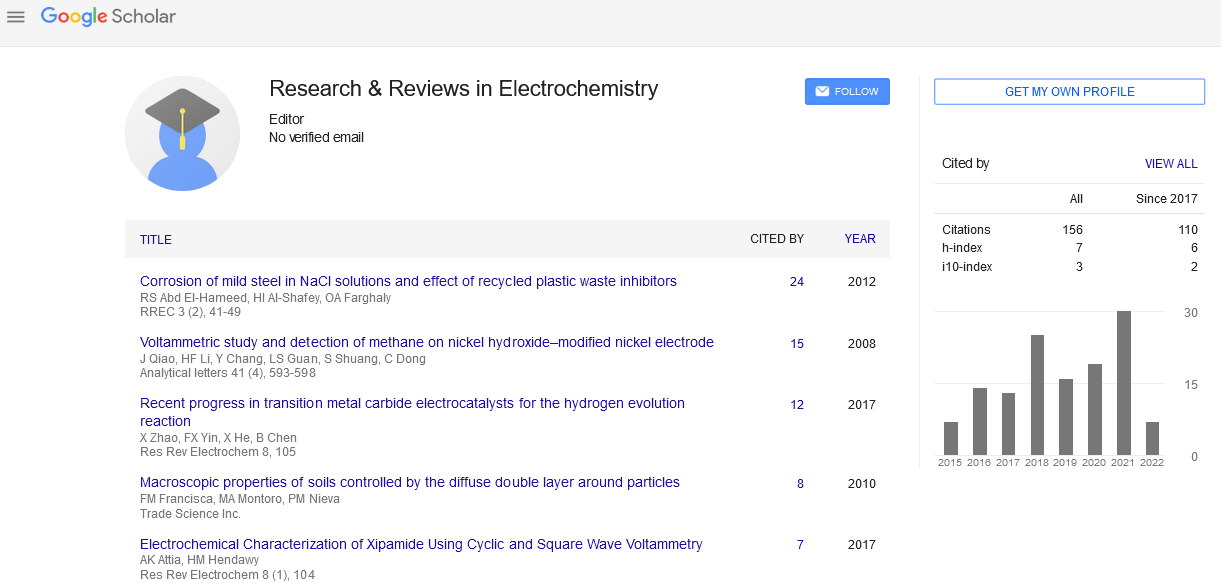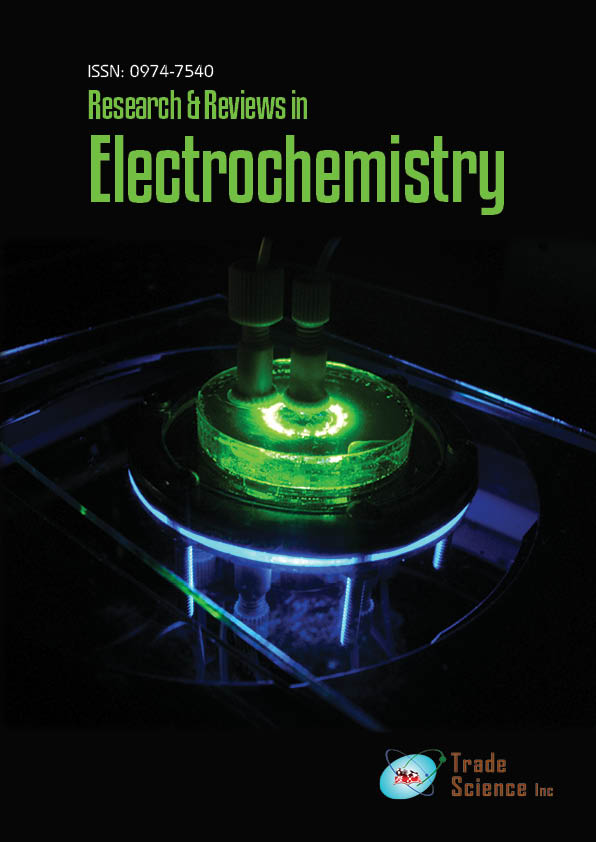Short communication
, Volume: 11( 2)Nitrogen-Phosphorus Doped Graphitic Nano Onion-like Structures
- *Correspondence:
- Amelia Smith
Editorial Office, Research and Reviews in Electrochemistry, UK
E-mail: publisher@tsijournals.com
Received: March 06, 2021; Accepted: March 07, 2021; Published: March 15, 2021
Abstract
In a variety of fields, graphitic structures resembling onions are quite useful. Pentagons, heptagons, and octagons are fundamental aspects of onion-like graphitic structures that could produce important qualities for a variety of applications, including anodes in Li metal batteries and the oxygen reduction reaction. These carbon nanomaterials are fullerenes organized in a nested fashion. In this work, we produced graphitic nano onion-like structures containing phosphorus and nitrogen (NP-GNOs), using the aerosol assisted chemical vapor deposition method. The NP-GNOs were produced utilising ferrocene, trioctylphosphine oxide, benzyl amine, and tetrahydrofuran as precursors at a high temperature (1020 °C). Different approaches were used to examine the morphology, structure, composition, and surface chemistry of NP-GNOs. The Fe-based nanoparticles inside the NP-GNOs have sizes of 110–780 nm. With an oxidation temperature of 724°C, thermogravimetric research revealed that NP-GNOs are thermally stable. Phosphorus–nitrogen codoping was discovered by FTIR and XPS research, as well as numerous functionalities containing C-H, N-H, P-H, P-O, and P[double bond, length as m-dash]. O, C [double bond, m-dash length] C-O bonds and O-O bonds.
Keywords
Graphene; Cyclic voltammetry; Hetrognueoes electron transfer
Introduction
The great surface area, low density, high temperature stability, and superior electrical conductivity of Graphitic Nano Onionlike particles (GNOs) have piqued interest. GNOs have been employed in lithium batteries, supercapacitors, medication delivery, 4 lubricants, catalytic supports, and water purification. GNOs have been made by a variety of methods, including arc discharge, 10 laser ablation, and chemical vapor deposition. CH4, toluene, 1,2-dichlorobenzene, and Tetra Hydro Furan (THF) were utilized as precursors in these techniques. GNOs with sizes ranging from 200nm to 600 nm were discovered. Nitrogen, boron, sulfur, beryllium, and phosphorus have all been doped into graphitic materials. They employed aniline monomers as a nitrogen source and phytic acid as a phosphorus source, and the final material had outstanding electro catalytic ORR and OER capabilities. They also reported developing a rechargeable Zn-air battery with good battery performance and cycling stability employing cooped carbon spheres as an electrocatalyst. Due to the presence of pentagonal rings, fullerenes are curved graphene sheets. Large fullerenes assembled in a stacked manner form onion-like formations. High electron irradiation of amorphous carbon or polyhedral particles produces graphitic onions. The acquired data revealed that ORR and OER were promoted at low over potential. Furthermore, its catalytic behaviour is shown to be superior to a typical catalyst for zinc-air batteries.
All of the chemical reagents used in this study were purchased from Sigma-Aldrich and were chemical grade-pure without further processing. The AACVD process was used to make the NP-GNOs. A condenser and an acetone trap for residuals are connected to the quartz tube. The sprayer was filled with a solution containing ferrocene (2.5%) as a catalyst, benzylamine (47.43%) as a nitrogen source, tetrahydrofuran (47.43%) as a carbon source, Tri Octyl Phosphine Oxide (TOPO) (2.5%) as a phosphorus source, and thiophene (0.125%) Ar (Infra, 99.999%) with a carrier flow of 1 L was used to convey the nebulized precursors generated inside the sprayer to the quartz tube reactor. The synthesis temperature was 1020°C for one hour. The GNOs were recovered by scraping the inside walls of the reaction quartz tube with a stainless-steel rod. The amount of GNOs produced was 1.51 g. Scanning Electron Microscopy SEM (FEI-Helios NanoLab DualBeam 600 Microscopy) and HighResolution Transmission Electron Microscopy HR-TEM were used to analyze the NP-GNOs (FEI Tecnai F30). Density Functional Theory (DFT) was used to do electronic calculations. The exchange-correlation functional40, as implemented in the SIESTA code, was chosen to use the generalized gradient approximation with the Perdew, Burke, and Ernzerhof parametrization. The average diameter of NP-GNOs and SEM images different magnifications of stacked aggregates consisting of spherical-shaped graphitic nanostructures with hundreds of microns in height. The concentric graphitic layers were visible in an inside view of a single graphite structure. The samples have a high amount of carbon (92 wt%) and oxygen (8% wt%), according to Electron Diffraction Spectroscopy (EDS) characterization Although there are various theories on how carbon onions grow, none of them are correct. The exact growth mechanism of these structures is unknown S3), however we think that our NP-GNOs are formed by a gas detonation mechanism due to the high temperature used in fabrication. 46 In this case, the Fe-based core might be passivated by Sulphur right away, preventing Fe-based nanoparticle growth. Different N-doping configurations (N-pyrrolic, N-quaternary, N -pyridinic) and N-functionalities were discovered during the surface investigation (amine and amide). P (double bond, length as m-dash) O and P-O bonds were seen in the NP-GNOs, which were attributed to phosphates or hydroxyl groups connected to phosphorus atoms doping the graphitic structure.

